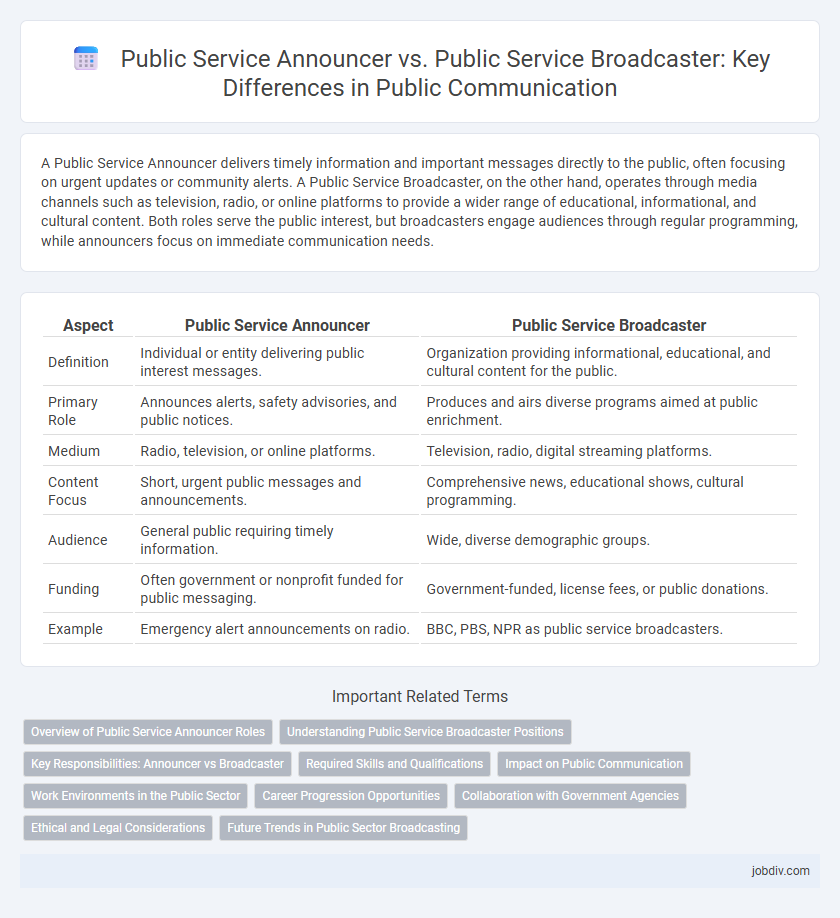A Public Service Announcer delivers timely information and important messages directly to the public, often focusing on urgent updates or community alerts. A Public Service Broadcaster, on the other hand, operates through media channels such as television, radio, or online platforms to provide a wider range of educational, informational, and cultural content. Both roles serve the public interest, but broadcasters engage audiences through regular programming, while announcers focus on immediate communication needs.
Table of Comparison
| Aspect | Public Service Announcer | Public Service Broadcaster |
|---|---|---|
| Definition | Individual or entity delivering public interest messages. | Organization providing informational, educational, and cultural content for the public. |
| Primary Role | Announces alerts, safety advisories, and public notices. | Produces and airs diverse programs aimed at public enrichment. |
| Medium | Radio, television, or online platforms. | Television, radio, digital streaming platforms. |
| Content Focus | Short, urgent public messages and announcements. | Comprehensive news, educational shows, cultural programming. |
| Audience | General public requiring timely information. | Wide, diverse demographic groups. |
| Funding | Often government or nonprofit funded for public messaging. | Government-funded, license fees, or public donations. |
| Example | Emergency alert announcements on radio. | BBC, PBS, NPR as public service broadcasters. |
Overview of Public Service Announcer Roles
Public Service Announcers (PSAs) deliver concise messages to inform the public about important issues, safety protocols, and community initiatives through various media channels. Their roles emphasize clear communication, urgent information dissemination, and behavioral influence to foster public awareness and engagement. Unlike Public Service Broadcasters who provide comprehensive content and programming, PSAs focus primarily on short, impactful announcements targeting immediate public response.
Understanding Public Service Broadcaster Positions
Public Service Broadcasters (PSBs) are media organizations committed to providing unbiased, diverse, and high-quality content that serves the public interest, typically funded by the government or license fees to ensure independence. Public Service Announcers, on the other hand, are individuals or entities delivering specific messages or campaigns within broadcasting schedules, focusing mainly on public awareness rather than comprehensive programming. Understanding PSB positions requires recognizing their role in promoting democratic values, cultural representation, and social cohesion through continuous, accessible media services.
Key Responsibilities: Announcer vs Broadcaster
A Public Service Announcer primarily delivers timely information, emergency alerts, and public interest messages directly to audiences through clear and concise verbal communication. In contrast, a Public Service Broadcaster manages and produces content across multiple media platforms, such as radio, television, and online channels, ensuring comprehensive coverage of public affairs, educational programs, and community services. While announcers focus on immediate message delivery, broadcasters oversee content creation, editorial decisions, and audience engagement strategies.
Required Skills and Qualifications
Public Service Announcers require strong communication skills, clarity in speech, and the ability to deliver concise, accurate information to diverse audiences, often needing a background in media, journalism, or communications. Public Service Broadcasters must possess advanced technical expertise in audio-visual equipment, content production, and editorial judgment, coupled with degrees in broadcasting, journalism, or related fields. Both roles benefit from experience in public relations, community engagement, and understanding regulatory compliance for public communication.
Impact on Public Communication
Public Service Announcers deliver targeted messages designed to inform and influence public behavior quickly, playing a crucial role in emergency alerts and awareness campaigns. Public Service Broadcasters provide comprehensive, unbiased programming that fosters informed citizenship and cultural understanding over time. Both enhance public communication by ensuring accessible, reliable information, but broadcasters offer sustained engagement while announcers drive immediate action.
Work Environments in the Public Sector
Public Service Announcers typically operate within government agencies or nonprofit organizations, focusing on delivering specific messages to inform or educate the public. Public Service Broadcasters work in state-funded media outlets, producing a wide range of content that promotes public interest, cultural values, and civic engagement. Both professionals often collaborate with public sector entities to ensure accurate communication within regulatory and policy frameworks.
Career Progression Opportunities
Public Service Announcers typically start with roles centered on delivering brief, targeted messages and may advance into content creation or coordination positions, gaining expertise in communication and media production. Public Service Broadcasters enjoy broader career progression opportunities, moving from reporting and presenting to editorial leadership, offer strategic influence, and often engage in multimedia journalism and audience engagement roles. Career growth in public service broadcasting tends to provide higher visibility, greater responsibility, and pathways into policy advocacy or media management within public institutions.
Collaboration with Government Agencies
Public Service Announcers primarily distribute government messages and emergency alerts created by official agencies, ensuring timely information reaches the public. Public Service Broadcasters collaborate closely with government organizations to develop content that promotes public welfare, transparency, and civic education. This partnership enhances trust and efficiency in communicating vital services and policies to diverse audiences.
Ethical and Legal Considerations
Public Service Announcers (PSAs) must adhere to strict ethical guidelines ensuring accuracy, impartiality, and respect for audience diversity, while complying with legal standards such as advertising regulations and privacy laws. Public Service Broadcasters (PSBs) operate under regulatory frameworks that mandate impartial content, transparency, and accountability to the public, often governed by broadcasting authorities and media law. Both entities face challenges related to censorship, data protection, and maintaining public trust, requiring ongoing legal compliance and ethical oversight.
Future Trends in Public Sector Broadcasting
Public Service Broadcasters are expected to leverage advanced AI technologies and data analytics to deliver more personalized and interactive content, enhancing audience engagement in the future. Public Service Announcers will focus on real-time, targeted communication, utilizing digital platforms to provide timely updates and critical information efficiently. Emerging trends highlight the integration of immersive media and cross-platform delivery to meet evolving public sector broadcasting demands.
Public Service Announcer vs Public Service Broadcaster Infographic

 jobdiv.com
jobdiv.com